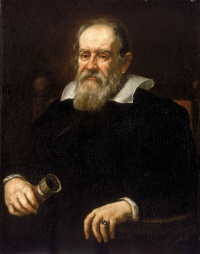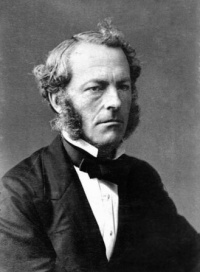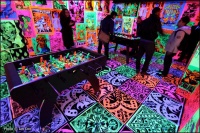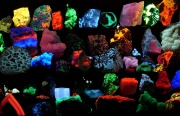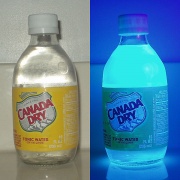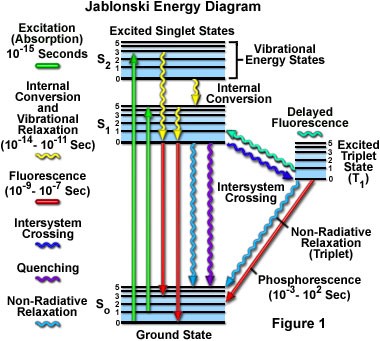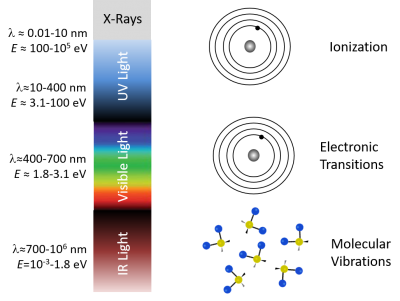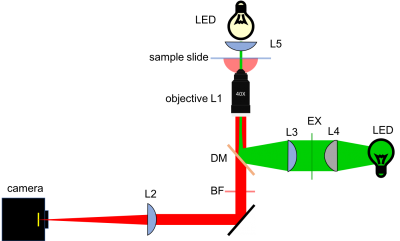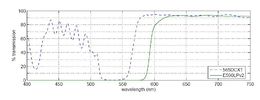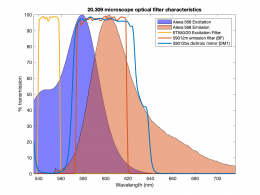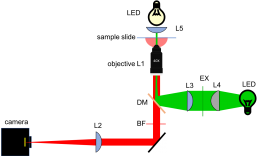Assignment 2 Part 2: Fluorescence microscopy
|
|
|
|---|
Overview
The phenomenon of fluorescence has beguiled both sober and inebriated witnesses since at least the late sixteenth century. Some of the earliest observers noticed an unusual blue tint in water that had been infused with the wood of a Mexican tree called Coatli. Other naturally-occurring fluorescent and phosphorescent materials such as Bologna Stone (baryte), fluorite, and quinine sparked considerable interest from some the most preeminent scientists in all of history. Galileo Galilei, Robert Boyle, David Brewster, John Herschel, and that trippy dude from your high school all spent time contemplating the curious nature and simple beauty of fluorescence.
The brilliant physicist and mathemetician George Stokes conducted a particularly clever experiment in which he used a prism to separate sunlight into its component colors. As he moved a vial of quinine sulfate from color to color, Stokes noted that quinine fluoresces only when illuminated by ultraviolet light — the invisible part of the rainbow just beyond the majestic blue band. The vial of quinine did not glow when Stokes placed the it in any other part of the rainbow. Because ultraviolet illumination gave rise to blue light, Stokes concluded that fluorescent emission has a longer wavelength than the excitation. This observation turns out to be spot on, and in his honor the difference in wavelength between the excitation and emission peak a fluorophore's spectrum is called the Stokes shift.
Reconciling Stokes' observation with the prevailing theory of light at the time of his experiment proved to be extraordinarily difficult. In classical electromagnetic theory, more intense light has a larger electric field than dim light. In this model, the intensity of the light ought to matter — not the color as Stokes observed.
Ultraviolet is the only color of light that excites quinine, regardless of how bright the light is.[1] In order to explain this, Albert Einstein had to dream up a whole new branch of physics: the quantum theory. Einstein introduced the idea in one of his "miracle year" papers in 1905 with the dense title of Concerning an Heuristic Point of View Toward the Emission and Transformation of light. It's is a lovely paper, and you should put it on your reading list. In the paper, Einstein posited that light is made out of discrete energy packets (which we now call photons).
The energy of photon depends only on its wavelength (color) and is given by the equation:
- $ E=h\nu=\frac{hc}{\lambda} $,
where ν is frequency, c is the speed of light, $ \lambda $ is wavelength and h is the Planck constant approximately equal to 6.626070040(81)×10−34 J⋅s. In Section 7 of Einstein's paper, he offered a persuasive theoretical argument for the correctness of Stokes' rule despite the fact that the mechanism of fluorescence was not known at the time: "If the fluorescent substance is not a perpetual source of energy, the principle of conservation of energy requires that the energy of an emitted energy quantum cannot be greater than of the incident light quantum.."[2]
Mechanism of fluorescence
The diagram below depicts the sequence of events that gives rise to fluorescence. The process begins when a molecule absorbs a photon. Absorbance increases the amount of energy stored in the molecule. Most of the energy goes into raising the energy level of an electron above its ground state. The remainder goes toward increasing the vibrational energy of the molecule. After absorbance, the molecule very rapidly sheds some of its energy through the processes of vibrational relaxation and internal conversion. Both of these processes convert some of the photon's energy to heat. After that, the molecule returns to its ground state by emitting a photon. Since some of the original photon's energy was lost to heat, the emitted photon has a longer wavelength (and hence lower energy) than the original one.
In 1933, Aleksander Jablonski published a simple diagram similar to the one below. The diagram shows the details of the energy transitions that that take place during fluorescence and phosphorescence. The vertical axis of the diagram represents total energy. Another implication of quantum physics is that electrons confined to a space (for example, bound to a molecule) can only occupy certain discrete energy levels. Allowable electronic energy levels are indicated by thick horizontal lines. The ground state S0 appears at the bottom of the diagram. Two excited states are shown: S1 and S2. As energy increases, the allowable states get closer together. Above each electronic energy level, fine horizontal lines represent energy stored in vibrational modes of the molecule. (Vibrational energy is also discrete.) Thus, each line represents a possible value for the sum of electronic and vibrational energy stored in a molecule.
The possible energy states are grouped into two columns. Each columns represents a different molecular spin state. (numbers of unpaired electron spins). Singlet states (denoted by the letter "S") have no unpaired spins while triplet states (denoted by "T") have two unpaired spins. Don't sweat the details too much. the bottom line is that transitions within a column are much more likely than transitions that cross columns. Fluorescence does not require an electron to change spin. It is a fast phenomenon that takes place entirely in the lefthand column. Phosphorescence involves an electron changing its spin. The probabilities of the transitions are much lower and hence phosphorescence occurs over a much longer timescale (up to hours).
It's not a coincidence that fluorescence takes place for the most part in visible wavelengths. As summarized in the diagram below, single photons with wavelengths longer than about 700 nm have energies less than about 1.8 electron volts (2.88×10-19 J), which roughly corresponds to the energy range of vibrational modes of molecules. Visible photons (λ= 400 - 700 nm) have energies in the same range as the differences between in energy levels of electrons bound to a molecule. X-rays (0.01 - 10 nm) have more than enough energy to completely remove an electron. Ultraviolet light bridges the gap.
Fluorescence microscope design
Excitation sources and optical filters
As shown in the block diagram, the major components required for fluorescence imaging are an illuminator (laser, L3, L4, and L5), dichroic mirror (DM), and emission filter (BF). The illuminator provides light in the appropriate wavelength range to excite the fluorescent molecules in the sample. Fluorescence microscopes that use broadand light sources such as arc lamps require an additional filter called an excitation filter to limit the wavelengths in the illumination to the proper range. Because lasers emit light in a very narrow range of wavelengths, an excitation filter is unnecessary.
Excitation light comes from beneath the sample, through the objective lens. A dichroic mirror directs the excitation toward the objective and sample. The mirror must reflect wavelengths in the excitation range and pass the longer wavelengths of the emitted fluorescence. In fluorescence imaging, illumination intensity is typically 5 or 6 orders of magnitude greater than emitted fluorescence, so it is crucial to filter out excitation photons as completely as possible. The dichroic mirror passes a substantial amount of green light, on the order of five percent. The barrier filter does a much better job of removing the green light, attenuating the excitation wavelengths by about 5 orders of magnitude. The barrier filter is essential for making crisp, high-contrast images.
In Assignment 3, you are going to make images using the fluorescent dye Alexa Fluor 568, manufactured by ThermoFischer Scientific. The peak excitation wavelength for the dye is 568 nm (as you may have surmised from the name). You will use a 5 mW, 532 nm green laser as a light source. This wavelength is not exactly at the peak of the absorbance spectrum, but it is still a reasonably efficient wavelength for exciting this dye — photon-for-photon, 532 nm will excite about 40% as many dye molecules as 568 nm. The reason for using this particular laser is that it is unbelievably inexpensive. 532 nm is the wavelength used in most green laser pointers. Mass manufacturing of 532 nm laser diodes and modules has reduced their cost to next-to-nothing.
Illuminator design
In contrast with the transilluminated bright-field approach where the LED incident light traverses the sample before reaching all image-forming optics, illumination for epi-fluorescence microscopy reaches the sample through the objective lens — from the same side of the sample that is observed. The rationale behind this design choice is the relative dimness of the fluorescence emission signal with respect to the needed excitation intensity. Even though fluorescence excitation and emission occur at distinct wavelengths and can thus be filtered away from one another, it is still advantageous to direct the very bright laser beam in the opposite direction from the imaging system.
The optical elements in the fluorescence illuminator include a laser source, two mirrors (not shown), three lenses, and a dichroic mirror. Many fluorescence microscopes utilize a white light source plus and excitation filter instead of a laser. Because the laser light source in our design is (very nearly) monochromatic, it is not necessary to use an excitation filter.[3]
Traveling through and focused by the objective lens, this collimated laser beam would result in single point illumination of the sample. To restore collimated excitation of a broader region of the sample, lens L5 must be inserted in the optical path... with the drawback that the laser beam's diameter, ~ 1.1 mm originally, thus becomes "minified" by a factor f5 / fobj, which would result in the illumination of a disc only ~ 25 μm in diameter!
A Gallilean beam expander (L3 and L4) is thus the final requirement of the microscope design. It allows the collimated laser illumination to match the CCD camera field of view. The focal lengths chosen for L3 and L4, and thus the expansion factor of the beam expander, are a tradeoff between uniformity and brightness of illumination, given the Gaussian shape of the laser beam. You must pick values for L3, L4, and L5. A few numbers will help: the detector in the camera has a diagonal measurement of about 6 mm; the laser beam has a diameter of about 1 mm; and it's difficult to position lens L5 closer than about 185 mm from the back focus of the objective lens.
References
- ↑ This is not perfectly true. We will talk about two-photon excitation later on.
- ↑ http://www.colorado.edu/physics/phys2170/phys2170_sp15/Library_files/A.%20Einstein,%20Ann.%20Phys.%2017,%20132%201905.pdf
- ↑ In practice, some lasers leak a bit of light at other wavelengths. You can use a narrow bandwidth filter called a laser line filter to eliminate the spurious wavelengths.
- Overview
- Part 1: Noise in images
- Part 2: Fluorescence microscopy
- Part 3: Build an epi-illuminator for your microscope
Back to 20.309 Main Page

